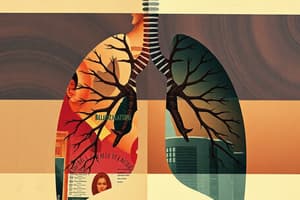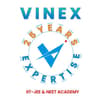Podcast
Questions and Answers
What is the function of the epiglottis during swallowing?
What is the function of the epiglottis during swallowing?
- To close the airway and direct food into the esophagus (correct)
- To enhance airflow through the larynx
- To support the thyroid cartilage
- To produce sound
Which region of the pharynx is located behind the nasal cavity?
Which region of the pharynx is located behind the nasal cavity?
- Nasopharynx (correct)
- Oropharynx
- Hypopharynx
- Laryngopharynx
What does the term 'glottis' refer to?
What does the term 'glottis' refer to?
- The pharynx and larynx combined
- The entire larynx
- The epiglottis and the larynx
- The vocal cords and the space between them (correct)
What type of cartilage forms the framework of the larynx?
What type of cartilage forms the framework of the larynx?
How many cartilages compose the laryngeal framework?
How many cartilages compose the laryngeal framework?
What happens to the glottis during inspiration?
What happens to the glottis during inspiration?
What is the primary function of the trachea?
What is the primary function of the trachea?
Which structure separates the superior lobe from the middle lobe in the right lung?
Which structure separates the superior lobe from the middle lobe in the right lung?
What is the primary role of pleural fluid?
What is the primary role of pleural fluid?
What is the hilum in relation to the lungs?
What is the hilum in relation to the lungs?
What is the primary reason for breathing in humans?
What is the primary reason for breathing in humans?
Which structure is NOT part of the principal organs of the respiratory system?
Which structure is NOT part of the principal organs of the respiratory system?
What function is specifically served by the conducting division of the respiratory system?
What function is specifically served by the conducting division of the respiratory system?
During which phase does gas exchange occur in the respiratory system?
During which phase does gas exchange occur in the respiratory system?
Which statement about the nose is incorrect?
Which statement about the nose is incorrect?
What is the role of the nasal septum?
What is the role of the nasal septum?
Which part of the respiratory system is primarily responsible for gas exchange?
Which part of the respiratory system is primarily responsible for gas exchange?
What are the nostrils referred to as?
What are the nostrils referred to as?
Which function is NOT related to the respiratory system?
Which function is NOT related to the respiratory system?
What is the main role of the alveolar walls during respiration?
What is the main role of the alveolar walls during respiration?
Flashcards
Respiration
Respiration
The process of taking in oxygen and releasing carbon dioxide.
Conducting Division
Conducting Division
The part of the respiratory system responsible for moving air from the nose and mouth to the lungs.
Respiratory Division
Respiratory Division
The part of the respiratory system responsible for gas exchange between the air and blood.
Inspiration
Inspiration
Signup and view all the flashcards
Expiration
Expiration
Signup and view all the flashcards
Alveoli
Alveoli
Signup and view all the flashcards
Pharynx
Pharynx
Signup and view all the flashcards
Larynx
Larynx
Signup and view all the flashcards
Trachea
Trachea
Signup and view all the flashcards
Bronchi
Bronchi
Signup and view all the flashcards
Nasal Conchae (Turbinates)
Nasal Conchae (Turbinates)
Signup and view all the flashcards
Meatus
Meatus
Signup and view all the flashcards
Pharynx (throat)
Pharynx (throat)
Signup and view all the flashcards
Larynx (Voice Box)
Larynx (Voice Box)
Signup and view all the flashcards
Epiglottis
Epiglottis
Signup and view all the flashcards
Glottis
Glottis
Signup and view all the flashcards
Vocal Cords
Vocal Cords
Signup and view all the flashcards
Trachea (Windpipe)
Trachea (Windpipe)
Signup and view all the flashcards
Study Notes
Respiratory System
- Breathing is essential for life, representing dramatic moments in human experience.
- Respiration is vital for ATP synthesis, as most metabolic processes directly or indirectly depend on ATP.
- Oxygen is necessary for ATP synthesis and creates carbon dioxide. Respiration is necessary for replacing oxygen and removing carbon dioxide.
- The respiratory system primarily involves tubes delivering air to the lungs. Oxygen diffuses into the blood, and carbon dioxide is removed. This system's key function is gas exchange.
Main Function
- The respiratory system provides oxygen to the blood and removes carbon dioxide.
- It has several functions, including gas exchange, communication (speech), olfaction (smelling), acid-base balance, and regulation of blood pressure.
- It aids in the expulsion of abdominal contents.
Upper Respiratory Tract
- The nose filters, warms, and moistens air.
- The pharynx (throat) is a common passageway for air, food, and liquid.
- The larynx (voice box) produces sound.
- The trachea (windpipe) is the main airway.
- The bronchi branch into smaller airways.
- Alveoli are air sacs for gas exchange.
Lower Respiratory Tract
- The trachea's 12cm, 2.5cm diameter tube is supported by cartilage.
- The trachea branches into two main bronchi, one for each lung.
- The trachea is situated anterior to the esophagus.
- The bronchi further divide into smaller bronchioles, terminating in alveoli.
Lungs
- Lungs consist of three faces: diaphragmatic, costal, and mediastinal.
- The structures entering and exiting the lung form the root (radix) pulmonis.
- The hilum is where these structures enter the lung.
- Lungs have lobes (right: three, left: two), separated by fissures.
Root of the Lung
- The mediastinal surface of the lungs has a slit called the hilum.
- The root of the lung contains the main bronchus, blood vessels, and nerves.
- The structures within the root supply the lungs.
Pleura
- The pleura is a double-layered membrane surrounding the lungs.
- Visceral pleura surrounds the lung tissue.
- Parietal pleura surrounds the visceral pleura externally and lines the thoracic cavity.
- The pleural cavity contains serous fluid to prevent friction.
Additional Notes
- Mouth: Airway for both air and food.
- Epiglottis: Closes the trachea during swallowing.
- Larynx: Produces sound; keeps food and liquids out of respiratory tract.
- Nasal Cavity: Warms, filters, and humidifies inhaled air.
- Pharynx: Passageway for air, food, and liquid.
- Trachea: Air passage.
- Bronchi: Air passages branching from trachea to lungs.
- Alveoli: Gas exchange sites in the lungs.
- Diaphragm: Muscle controlling breathing.
Studying That Suits You
Use AI to generate personalized quizzes and flashcards to suit your learning preferences.





